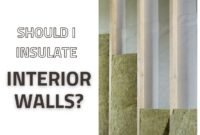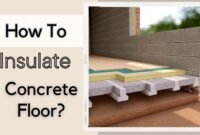Do you know about the combination of rigid foam over batt insulation? If you do not know yet, you may try it to insulate your house. But, before that, make sure to learn some brief information about that combination by reading this article.
Combining Rigid Foam and Batt Insulation
The combination of rigid foam over batt insulation can work well. Foam boards can enhance insulation while eliminating heat transfer when used in wall and ceiling constructions covered with batts. It can replace the vapor barrier as well as the house wrap.
Read also: Spray Foam vs Batt Insulation Pros and Cons

Below are four popular uses for properly combining foam board with batt insulation:
- To insulate the inner walls of the foundation or basement, apply foam board insulation to the foundation wall, then add batt insulation.
- To insulate the interior of below- or above-grade walls, foam board can be installed between the studs and covered with batt insulation.
- Add foam board insulation towards the ceiling joists’ underside to insulate the ceiling’s underside.
- To insulate the outer above-grade walls’ outer sides. There is foam board insulation between the sheathing and the housing cover.
Read also: Should I Insulate Interior Walls?
Is Rigid Foam Insulation Better Than Fiberglass?
Before applying rigid foam over batt insulation, you may wonder which one is better between those two. So, to help you understand it, below is a brief comparison.
The Materials
- Rigid Foam Insulation
Rigid foam insulation offers 4-by-8-foot panels in thicknesses ranging from 1/4 to 2 inches. That is also available in huge packaged panels with accordion-style ends for usage as an external sheathing component.
Rigid foam insulation possesses one of three different materials: top quality, ecologically sustainable polyisocyanurate; compressed polystyrene; or expanded polystyrene.
When exposed to moisture, rigid foam functions well and does not alter dimensions, fracture, or break. Spray foam insulation is frequently useful in wall voids. Though it dries firm, it is not rigid foam insulation.
- Fiberglass Insulation
Densely packed spun solitary batts (mono unrolled pieces) create fiberglass insulation.
Fiberglass, the opposite of rigid foam, is flexible and soft. The multitudes of air trapped in fiberglass insulation make an excellent protective layer, but the material may trap humidity, allowing mold and mildew to form. Fiberglass should not be used whenever moisture is present.
Fiberglass insulation consists of batts or rolls intended to suit conventional ceiling and wall cavities with framework sections separated by 16 or 24 inches in the center. Overall depths of the batts vary between 3 1/2 through 12 inches. Fiberglass insulation is available in rolls spanning between 24 and 40 feet or in packaged batts, typically 93 inches long.
Fiberglass insulation batts or rolls can be coated using paper to make fastening to frame members easier. Unfaced rolls or batts are the preferred options for placing as an insulation blanket.
Personal Experience
In my experience, combining rigid foam and batt insulation has significantly improved energy efficiency in several projects. For example, during a recent home renovation, we used foam board insulation to cover the basement walls and added batt insulation between the studs.
This approach improved the overall R-value and ensured a moisture-resistant barrier. A fellow expert once mentioned, “using foam board insulation over batt can prevent common moisture issues and enhance thermal performance.”
Cost
Before combining flash and batt with rigid foam, you must know the cost of both. Fiberglass insulation costs less than half of what rigid foam insulation costs when measured by the R-value for each square foot.
For instance, at R15, fiberglass insulation costs around $3.40 to $4.00 to insulate a 10-square-foot wall space. R-values for stiff foam are around $10.
Fiberglass insulation also produces less trash. When stiff foam gets size-cut, it generates little bits and thin parts that are nearly useless. Fiberglass insulation can get ripped off and tucked into tight spaces, resulting in little waste.
From my practical experience, while rigid foam insulation is initially more expensive, the long-term benefits of combining it with batt insulation can outweigh the costs. One case study highlighted that “rigid foam board, when used correctly, not only enhances insulation but also acts as a durable vapor barrier, providing long-term savings on energy bills.”
Thus, that is the important information about combining rigid foam over batt insulation. You can find more information about how they complement each other and contact the professionals who will install them.
| Aspect | Rigid Foam Insulation | Batt Insulation | Combined Use |
|---|---|---|---|
| Material | Polyisocyanurate, polystyrene | Fiberglass | Enhanced insulation, vapor barrier |
| Moisture Resistance | Excellent | Poor | Improved when combined |
| Cost | Higher | Lower | Cost-effective long-term |
| Application | External sheathing, wall voids | Standard wall and ceiling cavities | Optimal for walls, ceilings, basements |
Thus, that is the important information about combining rigid foam over batt insulation. You can find more information about how they complement each other and contact the professionals to install them.

